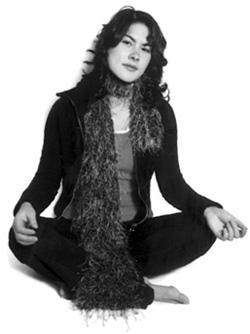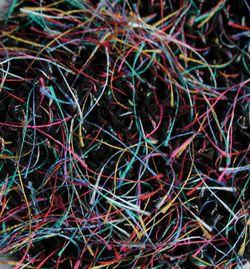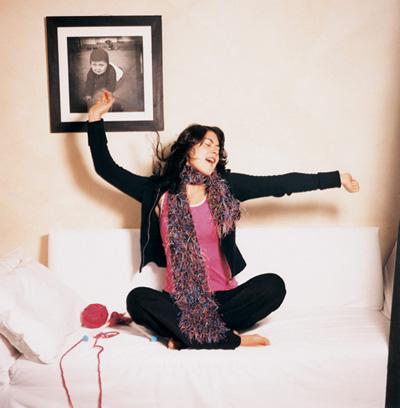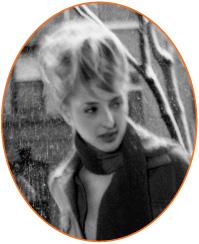Stitch 'n Bitch: The Knitter's Handbook (34 page)
Read Stitch 'n Bitch: The Knitter's Handbook Online
Authors: Debbie Stoller

Next come the actual instructions. Knitting patterns often give directions for more than one size. But instead of writing out the pattern over and over again for each size, it’s written like this: the first number given will refer to the first, smallest size, and the remaining sizes will be presented, from smallest to largest, in parenthesis, separated by commas. For instance, say you have a pattern for a hat that’s made for three sizes: baby bear, mama bear, and papa bear. The pattern might say:
Sized for baby (mama, papa) bears
And the first line of the pattern might read:
CO 24 (30, 38) st.
That simply means that for baby bear’s hat you’ll cast on 24 stitches, for mama bear’s hat you’ll make 30 stitches, and for papa bear you’ll do 38 stitches.
The next big thing to understand is the abbreviations. On this page you’ll find a list of the most common ones. Last, but not least, is the shorthand that knitting patterns use when they want you to repeat something a number of times. It’s a little on the funky side, but pretty easy once you understand it. For instance—
K2, *k2, p1; rep from * 6 times, k4
—translates into: Start your row by knitting 2 stitches (k2), then repeat what comes after the asterisks for the number of times given. In this case, you’d knit 2, purl 1, 6 times, and then finish with 4 knit stitches.
Finally, patterns that involve knitting pieces into somewhat complicated shapes will often give you schematics, or diagrams, of all the pieces you’ll be making, which can help you visualize what it is that you’re doing as well as compare your progress with what you should end up with.
ABBREVIATIONS | |
Beg | begin(ning)(s) |
BO | bind off |
CC | contrasting color |
Ch | chain |
Cn | cable needle |
CO | cast on |
Cont | continu(e)(ed) (es)(ing) |
Dec | decrease |
Dpn | double-pointed needle |
F&b | front and back |
Foll | follow |
Inc | increase |
Inc1 | bar increase (k in front and back of next st) |
K | knit |
M1 | make 1 increase |
MC | main color |
Meas | measures |
P | purl |
Patt | pattern |
Pm | place marker |
Pu | pick up |
Rem | remain(s)(ing) |
Rep | repeat(ed)(ing)(s) |
Rnd(s) | round(s) |
RS | right side |
Sc | Single crochet |
Skp | slip 1 st, k next st, pass slipped st over k st |
Sl | slip |
Ssk | slip next st knitwise twice, k sts tog tbl |
Sssk | slip next st knitwise 3 times, k all sts tog tbl |
St(s) | stitch(es) |
St st | stockinette st |
Tbl | through back loop |
Tog | together |
Yo | yarn over |
W&T | wrap and turn |
WS | wrong side |
ELLEN R. MARGULIES
A born-and-bred Brooklynite, now living in southern California, I thought I’d make a scarf for those days it does get chilly—only mine would be a little bit off. I went to my LYS (local yarn store) and came across this crazy multicolor yarn that reminded me of the rubber-band balls we used to make as kids. As I unwound the ball, the colored threads flared off in all directions, and I flashed back to my childhood, at the Coney Island fireworks. Every summer we’d sit on the boardwalk, feet dangling above the pitch-black beach, and we’d
ooh
and
ahh
as the sky lit up with an explosion of color. I had found my scarf.
Since the eyelash yarn was too thin to use alone, I combined it with a light cotton yarn to give it structure. Knit together, the yarns produced a scarf that was light and airy, and—
ooh
—really did look like a night at the fireworks!

SKILLS | PAGE |
CAST ON | |
KNIT | |
BIND OFF |

S
IZE
Approx 6" × 48", unstretched
M
ATERIALS
A:
Trendsetter Yarns
Shadow
(100% polyester; 20g/77 yds), 2 skeins #1 Black Multi
B:
Brown Sheep Company
Cotton Fleece
(80% cotton/20% merino wool; 4oz/215 yds), 1 skein #CW005 Cavern
US 15 (10mm) knitting needles, or size needed to obtain gauge
G
AUGE
13 sts and 14 rows = 4" in garter st with 1 strand each of
A
and
B
held tog
D
IRECTIONS
With 1 strand each of A and B held tog, CO 20 sts.
K all rows until both skeins of eyelash yarn are almost used up, leaving enough left over to BO. That’s all there is to it.

ABOUT ELLEN

The sound of clicking knitting needles was an ever-present accompaniment to my childhood. I always seemed to wear the most wonderful hand-knit ensembles, courtesy of my mother. But, being a stubborn teenager, I elected to teach myself knitting from a library book. I tend to keep my knitting techniques simple and let the threads’ complex personalities shine through. I know I have much to learn, but I’ve discovered something important: Even the most basic project can be a source of personal expression and deep satisfaction.
JENNIFER MINDEL
I kept seeing this “keyhole” scarf at stores in Chicago, and thought it would be great for our windy winters because it wouldn’t blow away. However, I didn’t like the colors or fibers of the ones I saw, so I said to myself, “I can do that.” I ended up making five last winter as gifts for friends and family (I even made a mini one for a friend’s baby girl). What’s great about this scarf is that it is quick to make and won’t break the bank.

SKILLS | PAGE |
CAST ON | |
KNIT | |
PURL | |
CHANGE COLOR | |
BIND OFF |
S
IZE
Approx 4½" × 40"
M
ATERIALS
Classic Elite
Bazic Wool
(100% superwash wool; 50g/65 yds)
A:
2 skeins #2958 Barn Red
B:
2 skeins #2961 Carnation